Analyses of Vibration Signals Generated in W. Nr. 1.0038 Steel during Abrasive Water Jet Cutting Aimed to Process Control
Abstract
:1. Introduction
2. Materials and Methods
3. Results and Discussion
4. Conclusions
Author Contributions
Funding
Data Availability Statement
Acknowledgments
Conflicts of Interest
References
- Available online: https://flowwaterjetblog.com/2015/02/03/how-one-small-change-made-waterjet-what-it-is-today/ (accessed on 30 July 2021).
- Liu, X.C.; Liang, Z.W.; Wen, G.L.; Yuan, X.F. Waterjet machining and research developments: A review. Int. J. Adv. Manuf. Technol. 2019, 102, 1257–1335. [Google Scholar] [CrossRef]
- Arola, D.; Fadale, T.; Ramulu, M. Heat Flux at the Erosion Boundary During Abrasive Waterjet Machining of Metals. In Proceedings of the 13th Symposium on Jetting Technology, Sardinia, Italy, 29–31 October 1996; Mechanical Engineering Publ.: Suffolk, UK, 1996; pp. 735–752. [Google Scholar]
- Arola, D.; Ramulu, M. A residual stress analysis of metals machined with abrasive waterjet. In Proceedings of the 13th Symposium on Jetting Technology, Sardinia, Italy, 29–31 October 1996; Mechanical Engineering Publ.: Suffolk, UK, 1996; pp. 269–290. [Google Scholar]
- Kovacevic, R.; Hashish, M.; Mohan, R.; Ramulu, M.; Kim, T.J.; Geskin, S. State of the art of research and development in abrasive waterjet machining. J. Manuf. Sci. Eng. 1997, 119, 776–785. [Google Scholar] [CrossRef]
- Hashish, M. Waterjets for aeroengine applications. In Proceedings of the 24th International Conference on Water Jetting, Manchester, UK, 5–7 September 2018; BHR Group Limited: Bedford, UK, 2018; pp. 207–217. [Google Scholar]
- Jurisevic, B.; Brissaud, D.; Junkar, M. Monitoring of abrasive water jet (AWJ) cutting using sound detection. Int. J. Adv. Manuf. Technol. 2004, 24, 733–737. [Google Scholar] [CrossRef]
- Axinte, D.A.; Kong, M.C. An integrated monitoring method to supervise waterjet machining. CIRP Ann. 2009, 58, 303–306. [Google Scholar] [CrossRef]
- Krenický, T.; Rimár, M. Monitoring of vibrations in the technology of AWJ. Key Eng. Mater. 2011, 496, 229–234. [Google Scholar] [CrossRef]
- Hreha, P.; Radvanská, A.; Knapčiková, L.; Królczyk, G.; Legutko, S.; Królczyk, J.; Hloch, S.; Monka, P. Roughness parameters calculation by means of on-line vibration monitoring emerging from AWJ interaction with material. Metrol. Meas. Syst. 2015, 22, 315–326. [Google Scholar] [CrossRef]
- Sutowski, P.; Sutowska, M.; Kapłonek, W. The use of high-frequency acoustic emission analysis for in-process assessment of the surface quality of aluminium alloy 5251 in abrasive waterjet machining. Proc. IMechE Part B J. Eng. Manuf. 2018, 232, 2547–2565. [Google Scholar] [CrossRef]
- Mikler, J. On use of acoustic emission in monitoring of under and over abrasion during a water jet milling process. J. Mach. Eng. 2014, 142, 104–115. [Google Scholar]
- Pahuja, R.; Ramulu, M. Surface quality monitoring in abrasive water jet machining of Ti6Al4V–CFRP stacks through wavelet packet analysis of acoustic emission signals. Int. J. Adv. Manuf. Technol. 2019, 104, 4091–4104. [Google Scholar] [CrossRef]
- Copertaro, E.; Perotti, F.; Castellini, P.; Chiariotti, P.; Martarelli, M.; Annoni, M. Focusing tube operational vibration as a means for monitoring the abrasive waterjet cutting capability. J. Manuf. Process. 2020, 59, 1–10. [Google Scholar] [CrossRef]
- Hase, A.; Mishina, H.; Wada, M. Correlation between features of acoustic emission signals and mechanical wear mechanisms. Wear 2012, 292–293, 144–150. [Google Scholar] [CrossRef]
- Pahuja, M.; Ramulu, M. Abrasive waterjet process monitoring through acoustic and vibration signals. In Proceedings of the 24th International Conference on Water Jetting 2018, Manchester, UK, 5–7 September 2018; BHR Group Limited: Bedford, UK, 2018; pp. 75–87. [Google Scholar]
- Ukpai, J.I.; Barker, R.; Hu, X.; Neville, A. Exploring the erosive wear of X65 carbon steel by acoustic emission method. Wear 2013, 301, 370–380. [Google Scholar] [CrossRef]
- Teti, R.; Jemielniak, K.; O’Donnell, G.; Dornfeld, D. Advanced monitoring of machining operations. CIRP Ann.-Manuf. Technol. 2010, 59, 717–739. [Google Scholar] [CrossRef] [Green Version]
- Kuntoğlu, M.; Salur, E.; Gupta, M.K.; Sarıkaya, M.; Pimenov, D.J. A state-of-the-art review on sensors and signal processing systems in mechanical machining processes. Int. J. Adv. Manuf. Technol. 2021, 116, 2711–2735. [Google Scholar] [CrossRef]
- Bointon, P.; Todhunter, L.; Clare, A.; Leach, R. Performance Verification of a Flexible Vibration Monitoring System. Machines 2020, 8, 3. [Google Scholar] [CrossRef] [Green Version]
- Ambhore, N.; Kamble, D.; Chincanikar, S.; Wayal, V. Tool condition monitoring system: A Review. Mater. Today Proc. 2015, 2, 3419–3428. [Google Scholar] [CrossRef]
- Ratava, J.; Lohtander, M.; Varis, J. Tool condition monitoring in interrupted cutting with acceleration sensors. Robot. Comput.–Integr. Manuf. 2017, 47, 70–75. [Google Scholar] [CrossRef]
- Hloch, S.; Ruggiero, A. Online Monitoring and Analysis of Hydroabrasive Cutting by Vibration. Adv. Mech. Eng. 2013, 5, 894561. [Google Scholar] [CrossRef]
- Copertaro, E.; Perotti, F.; Annoni, M. Operational vibration of a waterjet focuser as means for monitoring its wear progression. Int. J. Adv. Manuf. Technol. 2021, 59, 1937–1949. [Google Scholar] [CrossRef]
- Figlus, T.; Szafraniec, P.; Skrúcaný, T. Methods of Measuring and Processing Signals during Tests of the Exposure of a Motorcycle Driver to Vibration and Noise. Int. J. Environ. Res. Public Health 2019, 16, 3145. [Google Scholar] [CrossRef] [Green Version]
- Postel, M.; Aslan, D.; Wegener, K.; Altintas, Y. Monitoring of vibrations and cutting forces with spindle mounted vibration sensors. CIRP Ann.-Manuf. Technol. 2019, 68, 414–416. [Google Scholar] [CrossRef]
- Górka, J.; Kotarska, A. The quality of water jet cutting of selected construction materials. IOP Conf. Ser. Mater. Sci. Eng. 2018, 400, 022031. [Google Scholar] [CrossRef]
- Hlaváč, L.M. Revised Model of Abrasive Water Jet Cutting for Industrial Use. Materials 2021, 14, 4032. [Google Scholar] [CrossRef] [PubMed]
- Tyč, M.; Hlaváčová, I.M.; Kozelský, J. Monitoring of Abrasive Waterjet Cutting and Drilling. In Lecture Notes in Mechanical Engineering, Proceedings of the Advances in Water Jetting-Water Jet 2019, Čeladná, Czech Republic, 20–22 November 2019; Klichová, D., Sitek, L., Hloch, S., Valentinčič, J., Eds.; Springer Nature: Cham, Switzerland, 2021; pp. 242–251. [Google Scholar]
- Anderson, T.W.; Darling, D.A. A Test of Goodness-of-Fit. J. Am. Stat. Assoc. 1954, 49, 765–769. [Google Scholar] [CrossRef]
- Available online: https://www.itl.nist.gov/div898/handbook/eda/section3/eda357.htm (accessed on 31 July 2021).
- Spurrier, J.D. On the null distribution of the Kruskal–Wallis statistic. J. Nonparametr. Stat. 2003, 15, 685–691. [Google Scholar] [CrossRef]
- Abdi, H.; Williams, L.J. Tukey’s Honestly Significant Difference (HSD) Test. In Encyclopedia of Research Design; Salkind, N., Ed.; Sage: Thousand Oaks, CA, USA, 2010; Volume 3, pp. 1–5. [Google Scholar]
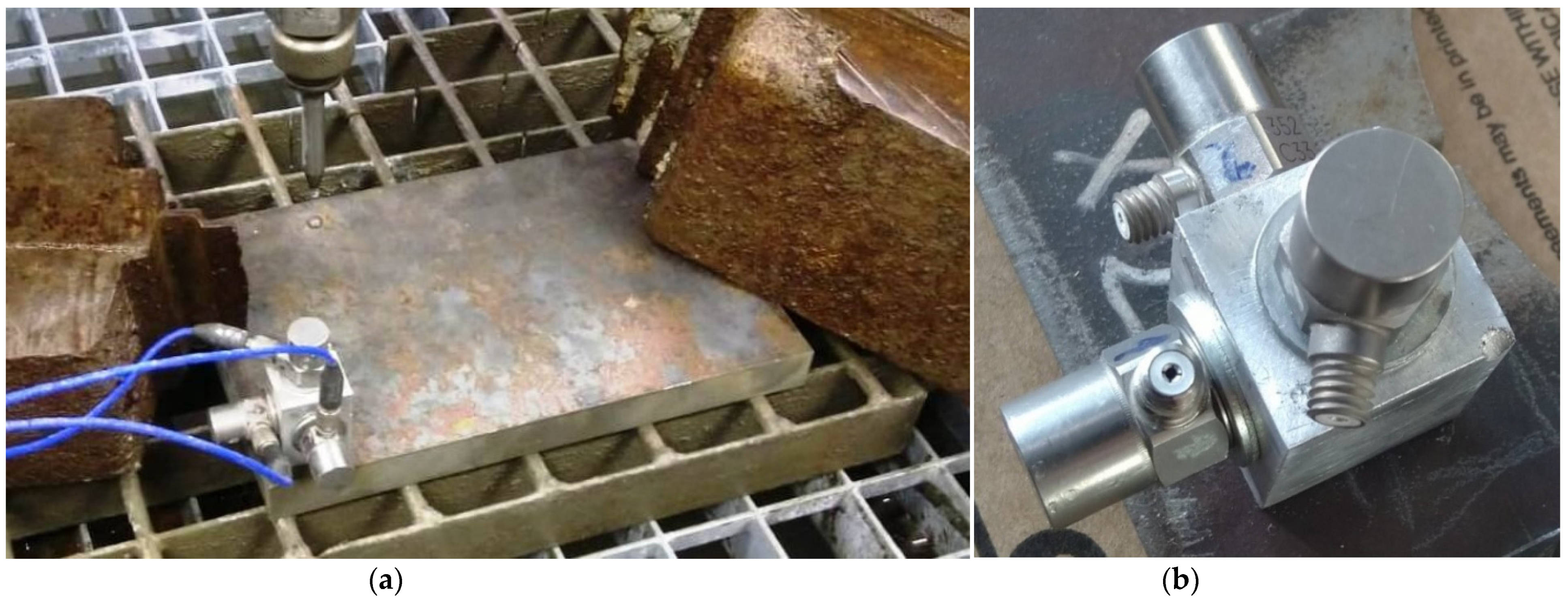
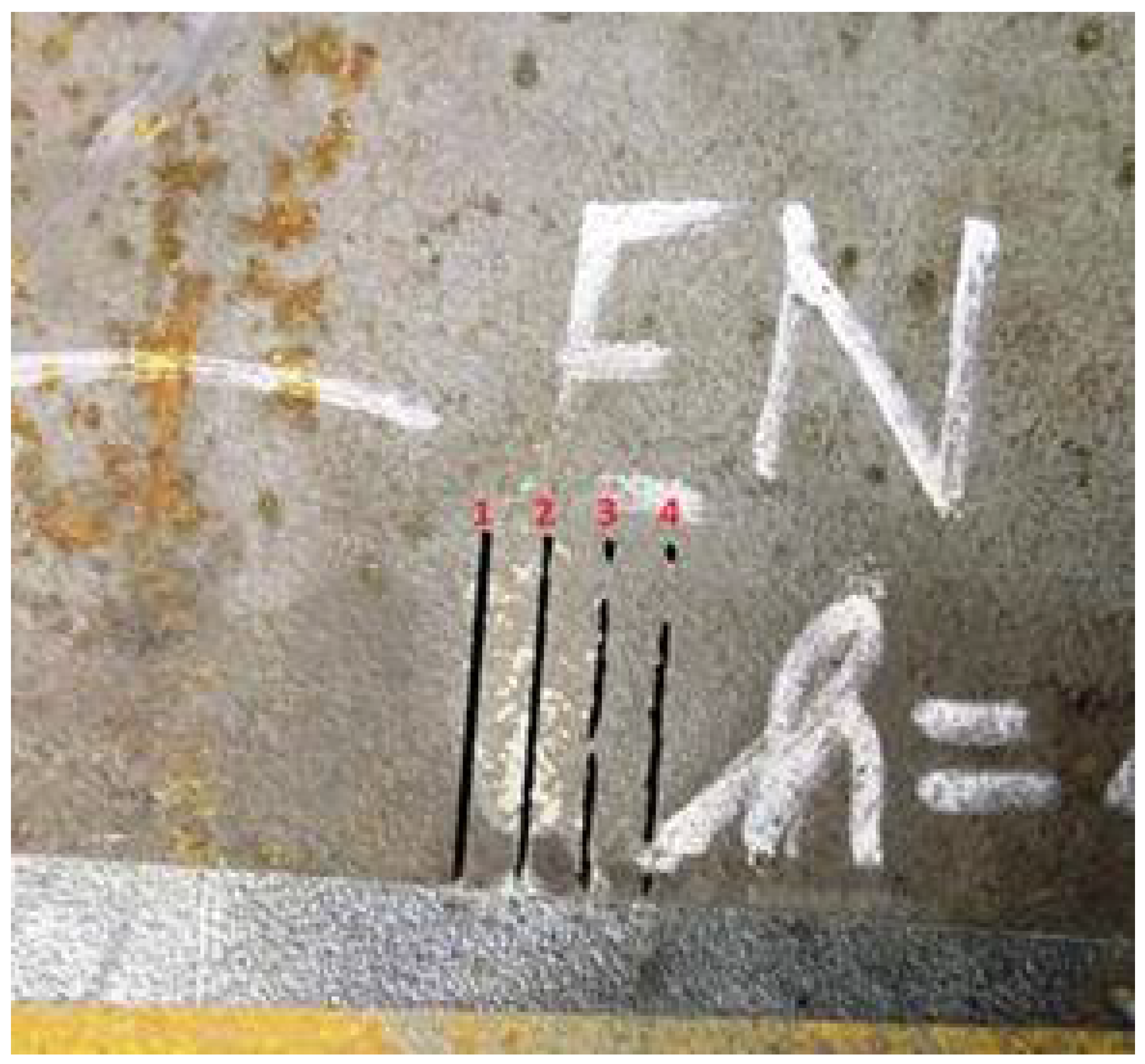

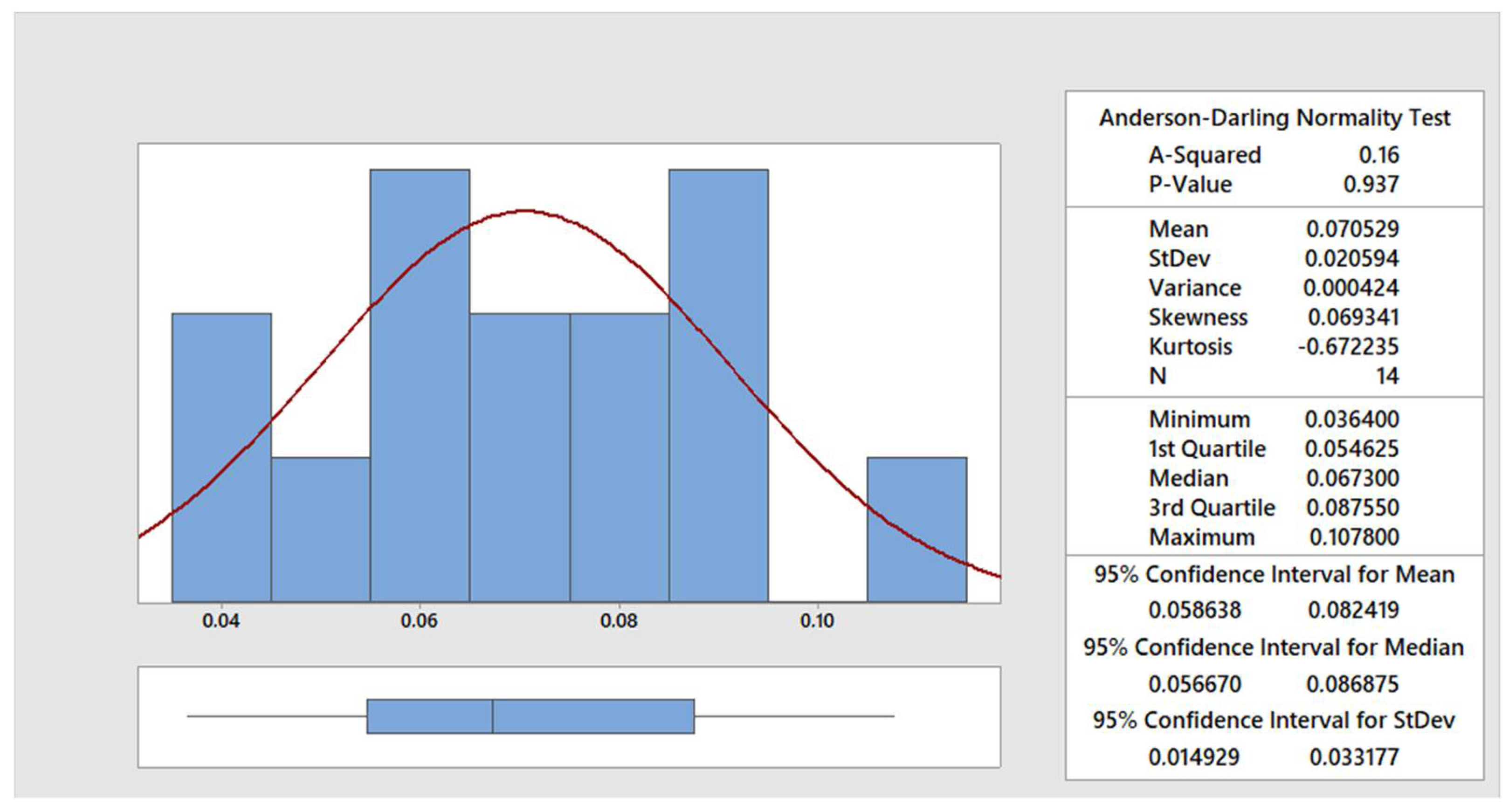
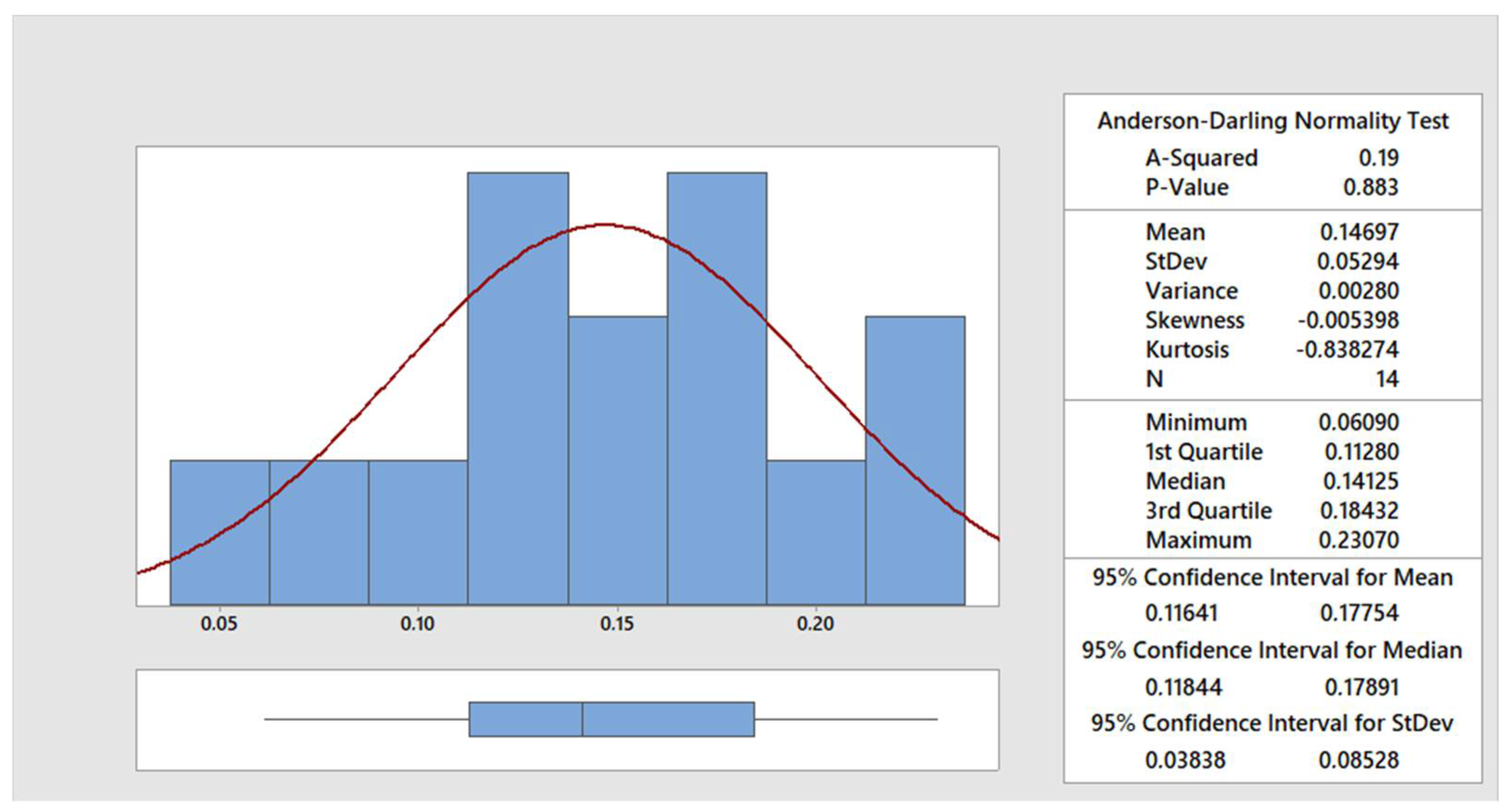


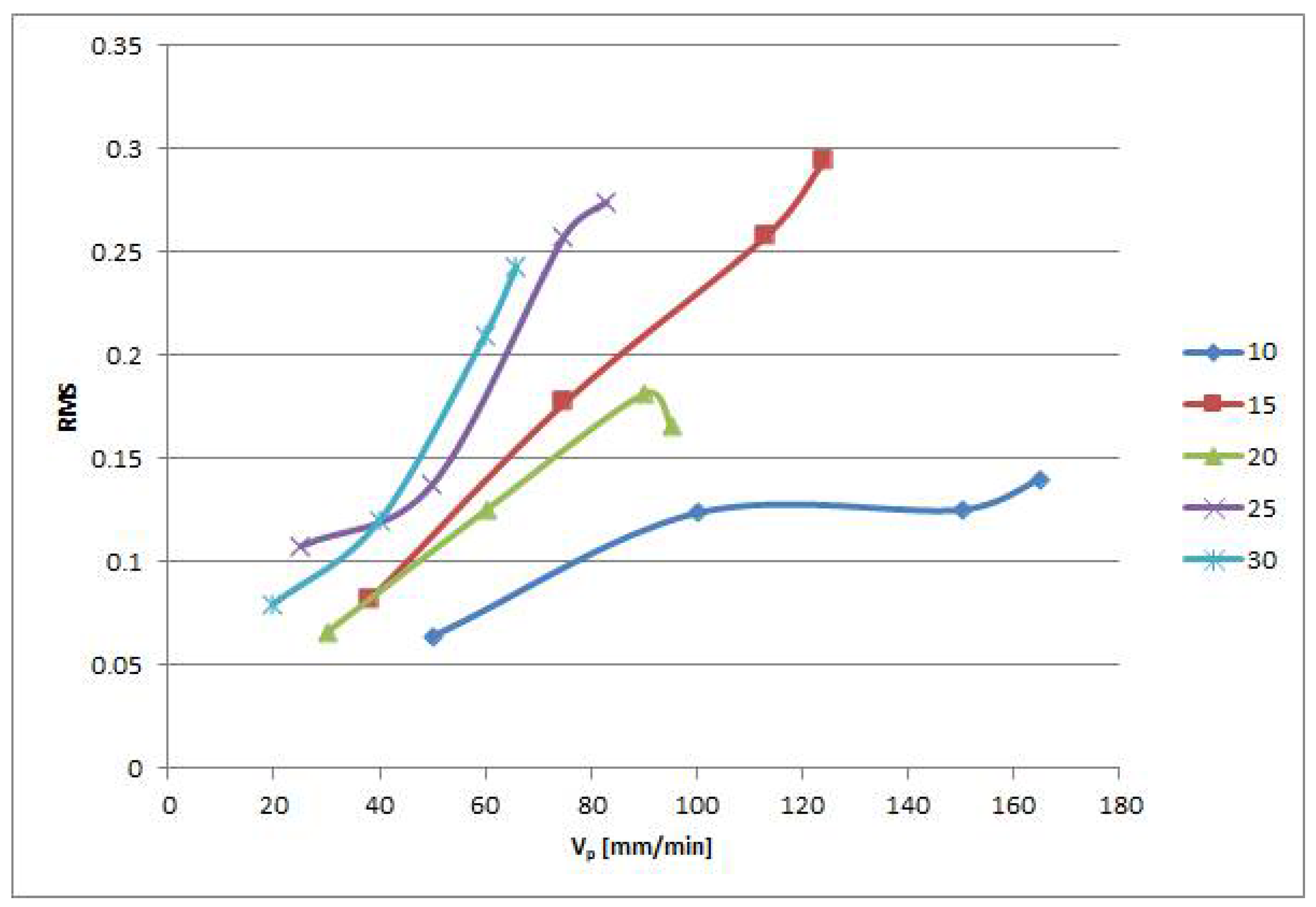
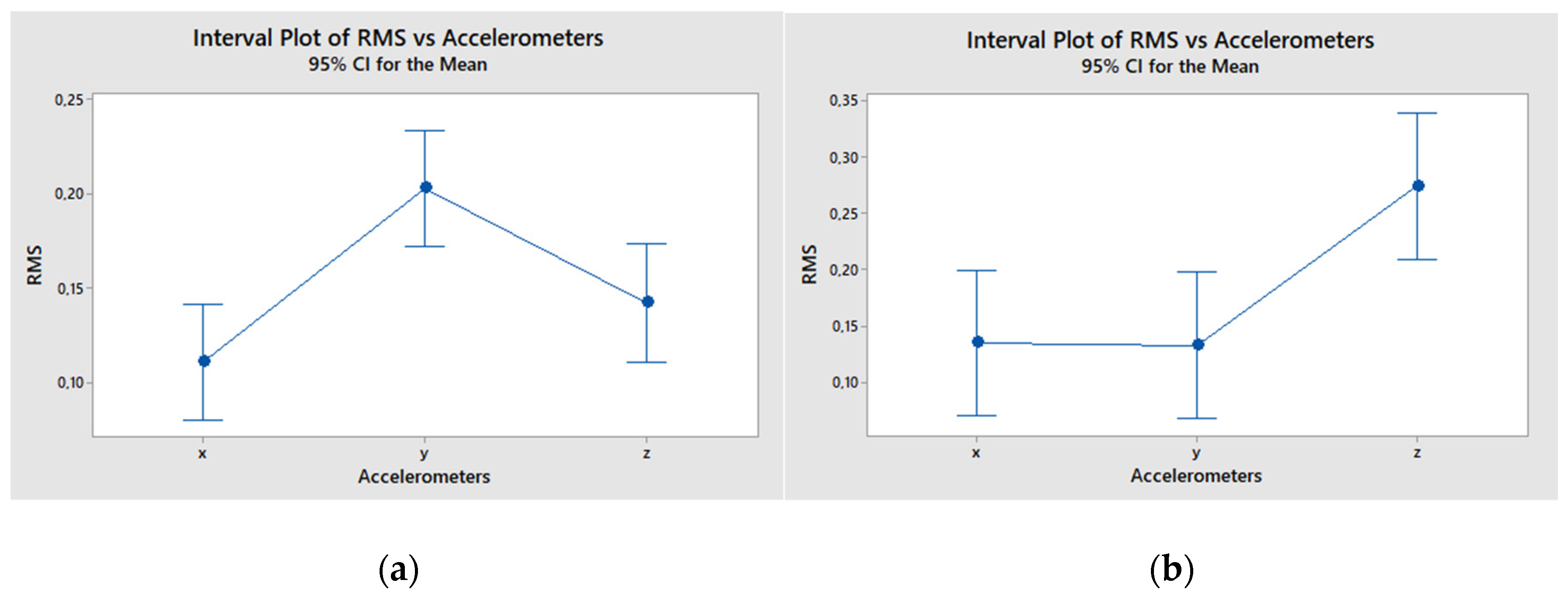
| Variable [Unit] | Value |
|---|---|
| Pump pressure [MPa] | 380 |
| Nozzle orifice diameter [mm] | 0.25 |
| Mixing tube diameter [mm] | 0.76 |
| Mixing tube length [mm] | 76 |
| Abrasive mass flow rate [g/min] | 250 |
| Abrasive type | Australian garnet #80 |
| Standoff distance [mm] | 2.5 |
| Cutting speed [mm/min] | 20–165 |
| C % | Si % | Mn % | P % | S % | N % | Cu % | |
|---|---|---|---|---|---|---|---|
| W. Nr. 1.0038 | max. 0.19 | - | max. 1.50 | max. 0.045 | max. 0.045 | max. 0.014 | max. 0.60 |
| Cutting Quality: | Thickness in mm | 10 | 15 | 20 | 25 | 30 |
|---|---|---|---|---|---|---|
| Excellent | Traverse speed vp | 50 | 38 | 30 | 25 | 20 |
| Good | 100 | 75 | 60 | 50 | 40 | |
| Separating cut | 150 | 113 | 90 | 75 | 60 | |
| Limit cut | 165 | 124 | 95 | 83 | 66 |
| Cut Quality | N | Median | Ave Rank | Z |
|---|---|---|---|---|
| Excellent | 14 | 0.0673 | 9 | −5.17 |
| Good | 14 | 0.14125 | 27.7 | −0.21 |
| Limit cut | 14 | 0.19985 | 39.9 | 3.03 |
| Separating cut | 14 | 0.1948 | 37.4 | 2.35 |
| Overall | 56 | 28.5 | ||
| H = 31.05; DF = 3; P « 0.001 | ||||
| Thickness [mm] | X | Y | Z | vp [mm/min] |
|---|---|---|---|---|
| 10 | 0.063765 | 0.090058 | 0.063130 | 50 |
| 10 | 0.123962 | 0.222298 | 0.169768 | 100 |
| 10 | 0.125512 | 0.23860 | 0.167805 | 150 |
| 10 | 0.140289 | 0.244911 | 0.184055 | 165 |
| 15 | 0.068251 | 0.081516 | 0.086712 | 38 |
| 15 | 0.144684 | 0.177507 | 0.204797 | 75 |
| 15 | 0.208192 | 0.257962 | 0.451108 | 113 |
| 15 | 0.195216 | 0.294343 | 0.237677 | 124 |
| 20 | 0.066276 | 0.112672 | 0.094817 | 30 |
| 20 | 0.125219 | 0.230684 | 0.177159 | 60 |
| 20 | 0.181439 | 0.375277 | 0.269824 | 90 |
| 20 | 0.165931 | 0.293618 | 0.204544 | 95 |
| 25 | 0.046918 | 0.107784 | 0.057235 | 25 |
| 25 | 0.060920 | 0.137836 | 0.091477 | 50 |
| 25 | 0.121212 | 0.258099 | 0.174038 | 75 |
| 25 | 0.121463 | 0.274494 | 0.158659 | 83 |
| 30 | 0.036423 | 0.079713 | 0.044846 | 20 |
| 30 | 0.045271 | 0.119909 | 0.071335 | 40 |
| 30 | 0.089390 | 0.209744 | 0.111748 | 60 |
| 30 | 0.088969 | 0.243477 | 0.132883 | 66 |
Publisher’s Note: MDPI stays neutral with regard to jurisdictional claims in published maps and institutional affiliations. |
© 2022 by the authors. Licensee MDPI, Basel, Switzerland. This article is an open access article distributed under the terms and conditions of the Creative Commons Attribution (CC BY) license (https://creativecommons.org/licenses/by/4.0/).
Share and Cite
Tyč, M.; Hlaváčová, I.M.; Barták, P. Analyses of Vibration Signals Generated in W. Nr. 1.0038 Steel during Abrasive Water Jet Cutting Aimed to Process Control. Materials 2022, 15, 345. https://doi.org/10.3390/ma15010345
Tyč M, Hlaváčová IM, Barták P. Analyses of Vibration Signals Generated in W. Nr. 1.0038 Steel during Abrasive Water Jet Cutting Aimed to Process Control. Materials. 2022; 15(1):345. https://doi.org/10.3390/ma15010345
Chicago/Turabian StyleTyč, Martin, Irena M. Hlaváčová, and Pavel Barták. 2022. "Analyses of Vibration Signals Generated in W. Nr. 1.0038 Steel during Abrasive Water Jet Cutting Aimed to Process Control" Materials 15, no. 1: 345. https://doi.org/10.3390/ma15010345






